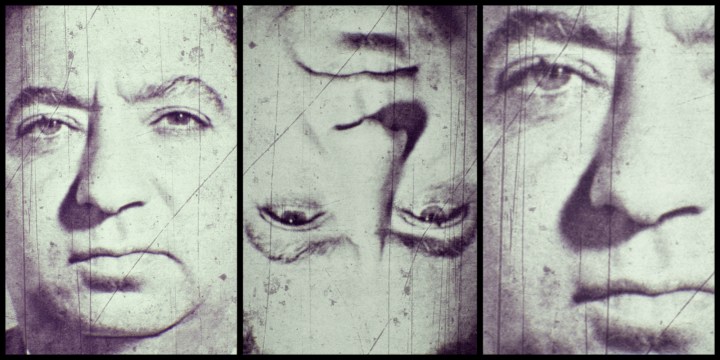OP-ED
All We Are Saying is Give Tapeworms a Chance

Sometimes madness can be an appropriate response to reality — a sentiment South Africans, heading to the polls on 8 May 2019 in the wake of the crazy State Capture era, should be able to understand as well as any other nation. Remember Dimitri Tsafendas?
Van Gogh cut off his ear and invented modern art as we know it. Kurt Gödel, a friend of Einstein and the inventor of a key mathematical technique, starved himself to death because he believed his food was poisoned.
Even Churchill, a gin-swilling saviour of liberal democracy, was so suicidal he told his doctor he always had to keep a pillar between himself and any railway track.
It’s true that mental illness can sometimes paralyse people. At other times it seems to function as a spur to greatness.
Elsewhere, it permits critical distance from social madness. Thus early Quaker abolitionist Benjamin Lay was so barmy he lived in caves and offered random visitors his earthly savings to burn his body. Yet he also saw the absurdity of an egalitarian religious order that tolerated slavery.
Enter perhaps South Africa’s most famous mad radical, Dimitri Tsafendas, the man who stabbed Hendrik Verwoerd to death in Parliament in 1966.
Judge Andries Beyers famously wrote in Tsafendas’ verdict: “I can as little try [him]… as a dog or an inert implement.”
Now, 50 years later, Tsafendas, who died in 1999, is provoking lively discussion again, thanks to a new and stunningly thorough biography of Tsafendas by Harris Dousemetzis. Dousemetzis argues that Tsafendas killed Verwoerd for political reasons and then faked his tapeworm to escape torture and the gallows.
Dousemetzis begins by painting a portrait of Tsafendas as a passionate communist, anti-imperialist, and anti-racist activist. Here, it must be said that the picture of Tsafendas’s life that emerges is perhaps slightly at odds with the portrait Dousemetzis apparently wishes to render, of a Lenin or Slovo-like figure, driven to a peripatetic lifestyle only by the pig-headed dogmatism of immigration authorities keeping a known communist from his homeland.
What emerged for this reader, however, was a figure more reminiscent of Lay or Gödel: a brilliant, yet an intermittently unstable man, given to frequent fights with employers, impulsive resignations and rapid changes of plans — someone whose visionary genius seemed inextricably tied up with a kind of madness.
Thus, at any number of points in the story Dousemetzis tells, Tsafendas might have settled down and had a good life for which, we are told, he deeply longed.
In 1961, for example, Tsafendas developed a reputation as an English teacher in the Istanbul Greek community. He charmed his pupils; became an honorary member of a priest’s family, showed around tourists and fielded marriage proposals.
Yet something gnawed at him, until in December 1961 he voluntarily uprooted himself for the dozenth time and headed for Portugal, via Bulgaria and Greece, in the hope of heading back to southern Africa.
Was it an intermittent tapeworm delusion that so goaded the man?
Tsafendas had, after all, been hospitalised for a tapeworm delusion at Grafton State Hospital, Massachusetts, in 1946, and again in Hamburg, in 1955. After the assassination, at least six psychiatrists confirmed his diagnosis of schizophrenia and/or delusion (Sakinofsky, MacGregor, Zabow, Kossew, Cooper, and Erasmus).
Even as late as 1996, long after any threat of execution had receded, he still discussed the worm in some detail with his first biographer, Henk van Woerden — a man even Dousemetzis admits Tsafendas trusted. Tsafendas told Van Woerden he’d contracted the tapeworm as a boy, but medicine had killed only half of it. Until the end, Tsafendas left instructions in his will for his body to be biopsied to find the worm.
Dousemetzis’ argument against all this rather compelling evidence is threefold.
First, he draws heavily on interviews he conducted with a wide range of friends and family who simply do not believe Tsafendas had the tapeworm. Especially important are two Greek Orthodox priests who visited Tsafendas in hospital at the end of his life — Father Minas Constandinou and Bishop Ioannis Tsaftaridis. Dousemetzis’ hypothesis is that Tsafendas felt a rare comfort with these two men, a closeness even beyond that he experienced with Henk van Woerden. This permitted him to tell them what we might call the alternative history of the worm.
Namely: In 1942, Tsafendas got the idea from a fellow mental patient in the Metropolitan State Hospital in Massachusetts, named Tom Tuff. Tuff, like Tsafendas, was supposedly faking illness to avoid the World War 2 draft. According to Dousemetzis, Tuff’s con trick—pretending to have a tapeworm delusion—raised no questions because of its bold, exotic originality.
So when a penniless Tsafendas next needed to fake insanity to get a meal and bed, in 1946, he supposedly borrowed Tuff’s story. Voila! Tsafendas’s new insanity show was a hit, and, the way Dousemetzis tells it, the man never looked back.
Second, Dousemetzis takes apart Tsafendas’s trial itself. Dousemetzis speculates that Major-General van den Bergh, chief of the Security Branch and head of the assassination investigation, might have suppressed evidence of Tsafendas’s sanity and encouraged Tsafendas’s torturers to pressure Tsafendas to blame a tapeworm for his act, so as to keep the apartheid security apparatus from looking weak and incompetent.
Dousemetzis also interviews the psychiatrists who diagnosed Tsafendas as schizophrenic and gets them to say that they were unable to check into Tsafendas’s medical history as thoroughly as they might have liked. Dousemetzis points out prosecutorial failures during Tsafendas’s summary trial, such as the failure to raise Tsafendas’s very lucid and political initial statement to the police after the assassination, which made no mention of a tapeworm.
Finally, Dousemetzis interviews some additional psychiatrists who tell him someone with such a tapeworm delusion, even an intermittent one, would have been likely to mention it to friends and confidantes. According to Dousemetzis, the only times Tsafendas did so prior to 1966 was always in the context of a joke about Tsafendas having been able to fool the educated whitecoats.
What to make of all this? Critics such as Imraan Buccus have called Dousemetzis’s case “unanswerable.” A petition by George Bizos and others to the Department of Justice and Constitutional Development calls for the government to acknowledge Dousemetzis’s new research and to revise educational curricula.
And indeed it would be silly to not recognise the power of Dousemetzis’s accomplishment. The fact that the assassination was politically motivated has been known for decades, and yet it has taken Dousemetzis to launch the long-overdue effort to officially acknowledge this.
Then, too, Dousemetzis has interviewed many dozens of confidantes of Tsafendas, and scoured what seems to be many hundreds of original documents.
Regarding the tapeworm, Dousemetzis certainly raises a plausible case, albeit not a watertight one.
His reasoning seems to boil down to: If Tsafendas didn’t “seem” schizophrenic to his community, and if he told a half dozen people he had faked a tapeworm, then by definition he must have been sane.
Yet neither of these assumptions seem sustainable. Recent literature about functional schizophrenia supports the idea that patients with active delusions can hold down jobs and maintain families far more successfully than Tsafendas ever did — especially when those delusions are intermittent. Testimonies describe the surprise of friends and acquaintances when the author reveals she experiences continual auditory hallucinations, implying an ability on the part of functional schizophrenics to hide their symptoms.
As for the boasts about fooling doctors, most people have met a charming raconteur in a bar or at a party who has been able to minimise her own mental vulnerability through self-deprecation, laughing off, for example, a suicide attempt as a play for attention.
Tsafendas took his tapeworm, fabricated or otherwise, to the grave with him. It is unlikely if we will ever know for sure whether he was telling the truth to Father Minas and Bishop Ioannis, or to Henk van Woerden, or both. Perhaps part of him experienced his tapeworm as a real delusion, while another part related to it as a strategic fabrication. Perhaps when his medications controlled his psychoses, it seemed to him as though the tapeworm had never been more than a tool, like the knife he used to stab the architect of apartheid.
Again, the push to rehabilitate him as a freedom fighter is overdue. Tsafendas needs a monument; an exhibition in the Apartheid Museum; rewritten textbooks; a primetime television special on the SABC.
Yet in the effort to serve Tsafendas justice, it is important not to accept the ableist terms of the apartheid state that first dismissed him as an “inert implement”.
Someone can, like the economist John Nash in the book and film A Beautiful Mind, be both delusional and brilliant.
A tapeworm can be right about tyrannicide. Killing a madman can be a gloriously rational act of lunacy that mitigates oppression.
Indeed, as Philip K. Dick noted, sometimes madness can be an appropriate response to reality — a sentiment South Africans, heading to the elections on 8 May 2019 in the wake of the crazy State Capture era, should be able to understand as well as any other nation. DM
Glen Relief’s The Jack Bank: A Memoir of a South African Childhood won a 2012 Lambda Literary Award. He is currently writing a speculative novel about Tsafendas’s tapeworm.















 Become an Insider
Become an Insider